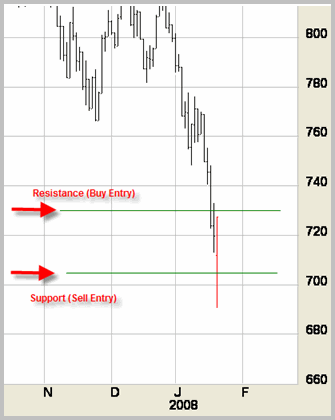Common Sense Strategies for the E-Mini’s
Would you like a simple, common sense way to trade the E-mini and other stock
index markets? While not a guarantee or risk-free, what I will lay out in the
next few paragraphs may be a solution for you as these volatile markets play out
over the rest of winter and into spring.
First, let’s take a look at what kind of markets we are dealing with. This
portion of the article is short because we are all painfully aware of what is
going on in the market place. My opinion is that the volatility we saw in 2007
is going to roll on through the majority of 2008 and perhaps beyond. So,
liquidate everything and move to a cabin in the mountains, or roll up our
sleeves and try to figure a way to profit from the hand that has been dealt us?
I’m choosing to play. If you are still reading this article then you agree
with me that these are volatile markets. In my opinion the way to trade in
volatile markets is by utilizing volatility breakout methodologies. There are
many ways to do that. Many of our clients use computerized trading systems to do
this. In this path, market data is inputted into a software program and based on
history and probabilities, the trading system outputs exact buy and sell points
that aspire to take advantage of volatile markets that are breaking out of a
trading range. The logic is that what follows consolidation is a break out,
either up or down in the markets. Volatility breakout traders hope to ride that
breakout for a specific period of time and hopefully make a profit.
For those traders not deploying a computerized system, here is one widely
used approach, Pivot Points.
1. Pivot Points. The pivot point tools are available in many forms on both
charting services as well as TradingMarkets.com and are a method to hopefully
define if a market has broken out. Pivot points basically use the high and low
points for a market and from there determine a middle, if you will or pivot
point. Then a calculation is made as to support and resistance. If a market
breaks out and goes above the resistance point there is a reasonable chance that
the market will continue in that direction in these volatile markets. The same
goes for the short side if the market goes down through the support level.
How to trade it
I recommend a three-to-one risk reward and further, I would stick to the
E-mini Russell and S&P 500 markets. Once you have determined the break out
point, put in an entry order on a stop at that point.
An illustration of this can be seen below on a Russell Index chart. The two
green lines show the pivot points, one above the market price and one below. If
the market touches either one, an entry is elected.

Mechanics of the Trade
Example: E-Mini S&P 500 currently at 1312.75
Resistance is marked as 1342.00
Place a buy stop @ 1342.00 and a profit target at 1348 ($300 profit before
fees and commissions). If the entry is filled, trail this with a $100 stop. If
the entry gets hit, you want to try and capture a $300 profit and risk $100. In
the case of the E-Mini Russell, I would try to capture $500 and risk $167 (3:1
risk ratio). If you enter the market and you don’t hit the profit objective or
the stop by the close of the US session, cancel the two orders and exit the
market. You can see from the illustration that in this case, you only get in the
market if it rallies up to your buy stop (a break out). If the market breaks out
and goes above the resistance point, in my opinion there is a reasonable chance
that the market will continue in that direction.

You can do the same strategy from the down side, placing the sell stop entry
at the support number and trying to capture a market move going down.
Key is to maintain your discipline and stick to a reasonable risk reward
ratio. Don’t fall into the trap of letting trades turn into a big loser and on
the winners, getting out too soon. Also, make sure you use the trailing stop. As
the market moves in your favor and is headed toward the profit objective set
your protective stop to trail the market as it goes in your favor. If it quickly
reverses field, you may be able to grab some profit or limit the damage.
After college graduation in 1986 Scot Hicks began his futures
career on the floor of the Chicago Board of Trade working as a runner on the
grain floor. Scot progressed to doing grain market research and then began
handling client business in 1988. From that time on, he has been involved in
some capacity of futures trading system administration or management. Scot
hasn’t seen it all, but he has seen a lot. Over the years he has written
articles for Futures Magazine, and SFO Magazine. Scot’s articles have also
appeared on Bondheads.com. Scot currently oversees operations for an Introducing
Broker head quartered in California called Trade Center, LLC. Scot is also one
of the producers of www.optionssense.com,
an options trading advisory. For more information on Trade Center go to
www.tradecenterinc.com.
